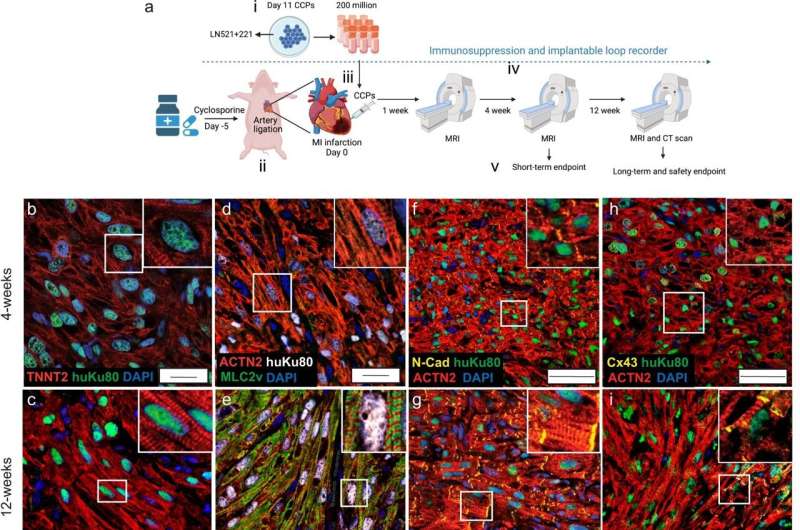This article has been reviewed according to Science X's editorial process and policies. Editors have highlighted the following attributes while ensuring the content's credibility:
fact-checked
trusted source
proofread
Researchers develop promising stem cell-based regenerative therapy for heart disease

A stem cell therapy treatment developed by Duke-NUS Medical School researchers for heart failure has shown promising results in preclinical trials. These cells, when transplanted into an injured heart, are able to repair damaged tissue and improve heart function, according to their study published in the journal npj Regenerative Medicine.
The most common cause of death worldwide is ischemic heart disease, which is caused by diminished blood flow to the heart. When blood flow to the heart is blocked, the heart muscle cells die—a condition termed myocardial infarction or heart attack.
In this study, a unique new protocol was used where pluripotent, or immature, stem cells were cultivated in the laboratory to grow into heart muscle precursor cells, which can develop into various types of heart cells. This is done through cell differentiation, a process by which dividing cells gain specialized functions. During preclinical trials, the precursor cells were injected into the area of the heart damaged by myocardial infarction, where they were able to grow into new heart muscle cells, restoring damaged tissue and improving heart function.
"As early as four weeks after the injection, there was rapid engraftment, which means the body is accepting the transplanted stem cells. We also observed the growth of new heart tissue and an increase in functional development, suggesting that our protocol has the potential to be developed into an effective and safe means for cell therapy," said Dr. Lynn Yap, an assistant professor at Lee Kong Chian School of Medicine, Nanyang Technological University, Singapore.
As the study's first author, Dr. Yap led the research while she was an assistant professor with Duke-NUS' Cardiovascular & Metabolic Disorders (CVMD) Programme.
In studies conducted by other groups, the transplantation of heart muscle cells that were already beating, brought about fatal side effects—namely, ventricular arrhythmia—abnormal heartbeats that can limit or stop the heart from supplying blood to the body.
The new procedure developed by Duke-NUS researchers involves transplanting non-beating heart cells into the damaged heart. After the transplantation, the cells expanded and acquired the rhythm of the rest of the heart. With this procedure, the incidence of arrhythmia was cut by half. Even when the condition was detected, most episodes were temporary and self-resolved in around 30 days. In addition, the transplanted cells did not trigger tumor formation—another common concern when it comes to stem cell therapies.
"Our technology brings us a step closer to offering a new treatment for heart failure patients, who would otherwise live with diseased hearts and have slim chances of recovery. It will also have a major impact in the field of regenerative cardiology, by offering a tried-and-tested protocol that can restore damaged heart muscles while reducing the risk of adverse side effects," said Professor Karl Tryggvason from Duke-NUS' CVMD Programme and the senior author of the study.
Prof Tryggvason, who is also the Tanoto Foundation Professor in Diabetes Research, is leading other studies to adapt this regenerative medicine method for patients with diabetes, macular degeneration in the eyes and those needing skin grafts.
Underpinning all these studies is a controllable, stable and reproducible method to make the right cells for transplantation using laminins—proteins that have a major role in the interactions of cells with their surrounding structures. Laminins exist in different forms depending on their environment and play a key role in directing the development of specific tissue cell types. In this study, stem cells were differentiated into heart muscle cells by growing them on the type of laminin abundantly found in the heart.
"To ensure patient safety, it is imperative that cell-based therapies show consistent efficacy and reproducible results. By extensive molecular and gene expression analyses, we demonstrated that our laminin-based protocol for generating functional cells to treat heart disease is highly reproducible," said Associate Professor Enrico Petretto, co-author of the study and Director of the Centre for Computational Biology at Duke-NUS.
The technology was licensed to a Swedish biotech startup earlier this year to further promote the development of cell-based regenerative cardiology.
More information: Lynn Yap et al, Pluripotent stem cell-derived committed cardiac progenitors remuscularize damaged ischemic hearts and improve their function in pigs, npj Regenerative Medicine (2023). DOI: 10.1038/s41536-023-00302-6




















